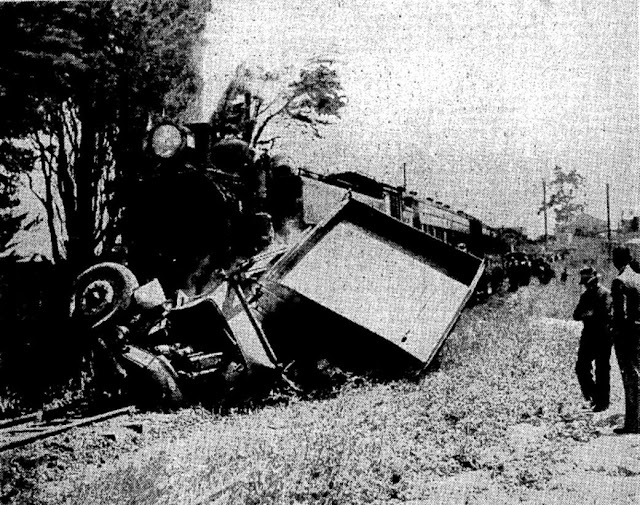One of the most tragic level crossing accidents in Auckland of recent years occurred on the St. Jude's Street crossing, Avondale, at 9.35 yesterday morning. Mr William Bramley was killed instantaneously when his truck was struck by a Swanson-bound passenger train and carried a distance of fifty yards along the line, ending as is shown in this striking picture. The engine of the train was disabled and had to be dragged away by a relief engine.
Evening Post 1 December 1937
Weekly News, 8 December 1937. Reference AWNS-19371208-57-2, Sir George Grey Special Collections, Auckland Libraries.
FATAL CROSSING SMASHAUCKLAND TRAGEDY,TRAIN HITS LORRY;VETERAN DRIVER KILLED(By Telegraph—Press Association.)
AUCKLAND, This Day.One of the worst crossing smashes in the recent history of Auckland occurred at 9.30 a.m. today, when W. Bramley, aged 55, a married man with a grown-up family, was killed outright. He was driving one of Winstone Ltd.'s lorries on the New North Road when, at the St. Jude's Street crossing, he was struck by a northbound passenger train. His body was thrown from the truck about twenty yards down the line, the lorry being carried a further distance of thirty yards.
Eye-witnesses said that Bramley, who was driving slowly, apparently heard and saw the train approaching, for he put up his hand, to advise following cars that he was stopping, but his truck continued on and was struck by the engine. It is thought that the lorry brakes failed. Bramley was the oldest driver in the employ of Winstone's and was regarded as one of the most careful on the road. The train had proceeded a few hundred yards from the Avondale Station when the fireman on the engine, D. Waller, saw the truck and other cars approaching the crossing, which is on a slope, and shrilled his whistle.
HAD TIME TO STOP.Neither the truck nor the train was travelling at more than 20 miles per hour, according to eye-witnesses. The truck had time to stop but did not. The engine-driver, G. R. Harris, applied the brakes instantly and the train stopped in its own length. The truck was caught under the cowcatcher and was dragged along the line. The warning-light standard was carried away, also part of a post, and the wire fence and cattle stops, were broken and scarred. Bramley suffered severe head injuries and was dead when he was picked up. The engine and cab of the lorry were damaged beyond repair. The train engine was so damaged that it had to be dragged away by a relief engine. Mr. Arthur Stych, who, with his brother, was driving a truck behind Bramley, said that when they approached the crossing the warning light was showing. They heard and saw the train. The lorry in front of them had just got on to the line when the train struck it.
Another eye-witness, Mr. G. R. Hampshire, the driver of a small, car on the other side of the crossing, said that Bramley's lorry ran on to the crossing at about three or four miles per hour. Apparently its brakes had failed.
The line was not cleared for over an hour after the accident.
Evening Post 30 November 1937



No comments:
Post a Comment